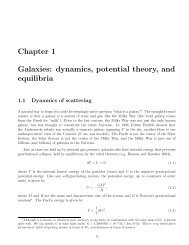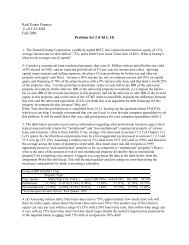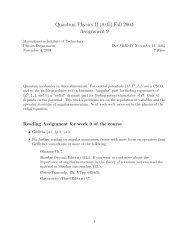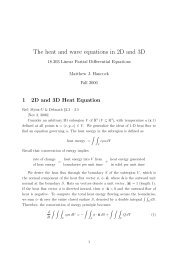Sean Faulk - MIT OpenCourseWare
Sean Faulk - MIT OpenCourseWare
Sean Faulk - MIT OpenCourseWare
Create successful ePaper yourself
Turn your PDF publications into a flip-book with our unique Google optimized e-Paper software.
<strong>Sean</strong> <strong>Faulk</strong>2/27/08Essay III-finalMake Way for the RobotsWith the seemingly limitless growth and advances in robotic technology has comeconcern over the unpredictable direction of such progress. This anxiety has manifesteditself mainly through artistic mediums, including some recently made films and essays—primarily The Matrix and “Marriage a la Mode”. Both these works illustrate the dangersof advanced robotics, especially in terms of the growing human-robot interaction, byemphasizing the loss of human connection and freedom that could potentially stem fromsuch technology. In The Matrix, as a result of superior artificial intelligence, robotsasserted their dominance and humans became slaves to the system by living in a virtualworld and becoming energy sources for the robots. A different twist on the future ofhuman-robot interactions is presented in “Marriage a la Mode,” where a husband andwife are both completely dependent on robots and computers and have never even seeneach other. In fact, the husband in the story has not been outside for years.While these are only futuristic visions and will most likely never happen, there iswithout a doubt some truth behind these speculations, and a cautionary message to beheard. The technology is already well on its way to creating robots that successfullyinteract with humans, and artificial intelligence is gaining momentum and interest as the21 st century progresses. Robots are being assembled that will one day perform domestichousehold tasks, replace human laborers, assist in therapy and hospitals, and tend to theelderly. Increased research and progress concerning adaptive robotic learning and humanrobotcommunication is clearing the path to a society in which one may not be able to tellthe difference between a robot and human anymore. This craze over and almost blindCite as: <strong>Sean</strong> <strong>Faulk</strong>. Course materials for 21W.730-5: Writing on Contemporary Issues: Imagining theFuture, Fall 2007. <strong>MIT</strong> <strong>OpenCourseWare</strong> (http://ocw.mit.edu/), Massachusetts Institute of Technology.Downloaded on [DD Month YYYY].
2drive towards progress, the desire to find ways for humans to avoid doing things, and theperhaps unconscious aspiration to play God and control everything around us may lead toa deprived world in some respects. Such a world would be not only a world deprived ofhuman labor, but also, and more importantly, a world deprived of individuality, comfort,and human connection—the essence of humanity.The ability to adapt to one’s environment and learn from experience is one heldby living creatures. Yet research is being done worldwide, including at <strong>MIT</strong>, toincorporate adaptation in robots. According to an article from the website RoboticsTrends, in late 2006, a small four-legged device demonstrated its ability to adapt to itsenvironment. The little robot essentially teaches itself to walk, and then when it isdamaged, it adapts and teaches itself to continue moving by limping. Rather than givingthe robot a specific set of codes to follow, “the researchers let it discover its own natureand work out how to control itself, a process that seems to resemble the way human andanimal babies discover and manipulate their bodies.” The robot is built as a “self-model”in that it is aware of its own structure and has “many, simultaneous, competing, different,candidate models” that allow it to change and adapt. The researchers believe that thesame algorithm and processes used to construct this robot could be translated into muchlarger, more complex machines.This research may seem like a forward step at first, but if one looks at theimplications of adaptation in robots, one may realize the possibilities. If robots becomemore and more adaptive and evolutionary, then the extent of their abilities may reach outof our control and the line of distinction between humans and robots could become evendimmer.Cite as: <strong>Sean</strong> <strong>Faulk</strong>. Course materials for 21W.730-5: Writing on Contemporary Issues: Imagining theFuture, Fall 2007. <strong>MIT</strong> <strong>OpenCourseWare</strong> (http://ocw.mit.edu/), Massachusetts Institute of Technology.Downloaded on [DD Month YYYY].
3Not only are robots being created to adapt to their physical environments, but theyare also being manufactured to respond and learn from human interaction. In a recentstudy at <strong>MIT</strong>, postdoctoral associate Aaron Edsinger has been working on a robot named“Domo” for three years and describes the robot as the ‘”next generation” of earlier robotsin that it is “designed to interact with humans” and “manipulate unknown objects.”According to the article on the <strong>MIT</strong> news webpage, Domo’s visual system is attuned tounexpected motion and can locate human faces and objects in human environments.Domo has the ability to sense when a human is touching it and respond, and Edsingerbelieves that such robots would be “useful in the home,” but “it’s important for them tohave a humanoid form, so people will feel more comfortable around them.” However, itis my opinion that no comfort will exist between a human and robot as it does betweenhumans because the human will always be aware that its partner is an artificial machine.And even if the robot looked exactly like a human, the knowledge that it is in fact abunch of wires and was made in a factory would make the interaction even scarier. Whilerobots that perform all household chores are still a dream (for some people), it isbecoming a reality in the labs of <strong>MIT</strong> where robots are opening water bottles and talkingto eager researchers.An example of an up-and-coming system that brings together all of the abovecomponents, including adaptability, communication, and assistance, is Intelligent Space(iSpace). According to an article in the acclaimed journal Artificial Life and Robotics,researchers are beginning to assemble a platform on which to implement advancedtechnologies to perform “smart services” for humans. This space can be a room, corridor,hallway, or wall. The space includes color information, networking multi-cameras, aCite as: <strong>Sean</strong> <strong>Faulk</strong>. Course materials for 21W.730-5: Writing on Contemporary Issues: Imagining theFuture, Fall 2007. <strong>MIT</strong> <strong>OpenCourseWare</strong> (http://ocw.mit.edu/), Massachusetts Institute of Technology.Downloaded on [DD Month YYYY].
4human-following mobile robot system, a path generator, and a number of other state-ofthe-artrobotic and sensory technologies. Proposed by the Hashimoto laboratory in theUniversity of Tokyo a few years ago, the concept of intelligent space has the ultimategoal of providing an interactive space that “comprehends human intentions and satisfiesthem.” It uses computer monitors to observe the clients and mobile robots to navigateabout the space and provide assistance. The space could be a room, corridor, or street,and is a cooperative system containing a network of computers and robots that has theability to learn and adapt through these distributed intelligent networked devices(DINDS). Its artificial spatial memory allows for the efficient exchange of informationand assistance between humans and the iSpace. Although it is well on its way, more workis being done on this revolutionary technology in order to turn it into an efficient,beneficial, and safe reality in the near future.But the increase in human-robot interaction and the further “humanizing” ofrobots fosters concern over the future. Will people be comfortable in a space under thecontrol and surveillance of robots at all times? Will humans that already perform assistivejobs such as doormen, waiters, and caretakers cease to exist? And will such humanconnection that we take for granted in these small situations be broken by this newtechnology? I think these are valid questions to consider before digging ourselves deeperand deeper into the hole of irreversible technological advances. The stories of TheMatrix, “Marriage a la Mode,” and countless others suggest that robotic technology coulddo damage to our society, and I agree that integration can create discomfort andemptiness among humans due to the vanishing of human-human interaction to make wayfor the robotic technology. Furthermore, as described in vast amounts of science fiction,Cite as: <strong>Sean</strong> <strong>Faulk</strong>. Course materials for 21W.730-5: Writing on Contemporary Issues: Imagining theFuture, Fall 2007. <strong>MIT</strong> <strong>OpenCourseWare</strong> (http://ocw.mit.edu/), Massachusetts Institute of Technology.Downloaded on [DD Month YYYY].
5these actions may lead to unpredictable consequences because we thought they wereunder our control. There is a basis behind such stories, and it is the failure of humanity toresist progress, or at least adequately consider its effects.Although the iSpace is still underway and has not yet become a reality, there arerobots out there right now that are very real in terms of their autonomous behavior andtruly scary abilities. In a book titled Advances in Human-Robot Interaction, scientistsrefer to the “dream” of assistive robots that carry out a number of chores, including“playing with the children,” and believe it is worth pursuing due to “considerableeconomic and social potential.” They hope that one day robots will “be instructed aseffectively and intuitively as a human,” and see that the major barrier to this “dream” isthe interface between and coexistence of humans and robots. In 1999, a project calledMORPHA began in Europe with the central idea of equipping robots with “powerful andversatile mechanisms, which would enable these robots to communicate, interact, andcollaborate with human users in a natural and intuitive way”(10). Such mechanismsinclude natural communication and speech, mimic, gesture, exertion and force sensors,touch, and coordination. The project was completed in 2003.The troubling thing about such a project is that it seems they simply want tocreate another human. Scientists and researchers are obsessed with the idea ofmanufacturing a machine that is like a human in every way, shape, and form. Thisappears to be paradoxical because of the extreme population growth that is projected forthe next decades. Competition for work will become fiercer than it already is for realhumans even without the introduction of robots who will undoubtedly replace manylaborers. Although roboticists everywhere, including the writers of the book Advances inCite as: <strong>Sean</strong> <strong>Faulk</strong>. Course materials for 21W.730-5: Writing on Contemporary Issues: Imagining theFuture, Fall 2007. <strong>MIT</strong> <strong>OpenCourseWare</strong> (http://ocw.mit.edu/), Massachusetts Institute of Technology.Downloaded on [DD Month YYYY].
6Human-Robot Interaction, assert that the robots will serve primarily assistant roles andhumans and robots will be “partners in joint manufacturing processes”(105), our searchfor efficiency will inevitably make human workers unnecessary as the machines takeover. And where will the humans go then?According to the book, scientists at the Hanover Industrial Fair in 2002successfully demonstrated a number of cutting-edge robotic abilities. In a series of testscalled “OrderPicking” and “CarrierClear,” a manufacturing assistant robot placed objectsin different containers and then returned them to their original position. It never failedafter multiple runs. In a “robotic bar scenario,” a robot named “MobMan” demonstrated“flexible grasp-and-place skills, speech, face detection”(231) and other higher-levelbehaviors such as opening doors, navigating, and cleaning. And a number of other robotsat the fair, including “Care-O-bot” and “Cora”(Cooperative Robot Assistant),demonstrated mobility, vision, force senses, speech, gestures, and recognition. It seemsthat scientists have essentially just created humans that can be put under their control. Butnow that control comes without the guilt (or legality) that stems from violation of humanrights or free will.The idea of human-robot interaction is on the forefront of current artificialintelligence research, especially the subtopic of human-robot communication. Roboticistsbelieve that it is vital to build robots with strong natural communication abilities in orderto attain acceptable integration. In his thesis titled “Coordinating Human-RobotCommunication,” <strong>MIT</strong> graduate student Andrew Brooks declares that it is essential to“build more complex, communicative robots, and more of them”(8). His graduate workconsisted of testing four different robots, each designed for different proficiencies, andCite as: <strong>Sean</strong> <strong>Faulk</strong>. Course materials for 21W.730-5: Writing on Contemporary Issues: Imagining theFuture, Fall 2007. <strong>MIT</strong> <strong>OpenCourseWare</strong> (http://ocw.mit.edu/), Massachusetts Institute of Technology.Downloaded on [DD Month YYYY].
7improving the communication skill set of such robots. He successfully demonstratedmimicking, self-modeling, inward attention, “multimodal gestural grammar,” “behavioraloverlay”(189), comprehensive communication repertoire and “personality,” timed actionsequences, and interactive communications in the robots. In other words, the robotsperformed natural speech involving body language and facial expressions, wereessentially aware of themselves, and could reason and effectively learn without the use ofcode or pre-arranged script.In another article in Artificial Life and Robotics, researchers Johan Bos andTetsushi Oka describe a similar study as the one above in which they fine-tune roboticspeech: “A successful implementation of a talking robot requires a good understandingof…acoustic signals, the syntactic structure of the language, the meaning associated withit, and the underlying goals derived from it”(44). In their research, they developed aspoken dialogue system and matched it with the interface of a real robot, called the RWIMagellan Pro, in order to create a robot that “react[ed] to contradictory information orobvious information”(44) and answered questions. The robot also used a speakerindependentspeech recognition system developed by Nuance, which allowed the robot’sspeech to sound much more natural and fluid.The research above shows that there are robots out there today that could easilypass as human if you were blindfolded and having a conversation with them. The extentof technology has come so far that robots are being built that are human-like in so manyways—in movement, form, speech, ability, and senses, to name a few. In fact, suchmachines are becoming more and more similar to humans each day, and that line thatseparates humans from robots becomes dimmer and dimmer. If the world of the present isCite as: <strong>Sean</strong> <strong>Faulk</strong>. Course materials for 21W.730-5: Writing on Contemporary Issues: Imagining theFuture, Fall 2007. <strong>MIT</strong> <strong>OpenCourseWare</strong> (http://ocw.mit.edu/), Massachusetts Institute of Technology.Downloaded on [DD Month YYYY].
8one with speaking, adapting, monitoring, mobile, autonomous robots, what will the futurebe like? Will humans and robots integrate without fear or discomfort? Or will the storiesof science fiction writers for decades become realities as the world becomes a bleak placevoid of human passion or care and filled with chaos and monotony? Of course there aresituations where advances in robotic technology are truly advantageous. An excellentexample is the use of robots for space missions, where human lives are not put at risk inspace thanks to robotics. However, it is clear that even today, robots are capable ofincredible but scary things. The integration of humans and robots is already occurring andscientists are urging it to continue and to accelerate. But this human-robot interactioncomes with a heavy price. As we become more advanced, it is probable that the growingpopulation will struggle even more to find jobs, and the presence of robots in our societywill make us less comfortable. But more importantly, the concept of our genuine“humanness” will fade, and the inherent spiritual connection among all humans will belost as we make way for the robots.Cite as: <strong>Sean</strong> <strong>Faulk</strong>. Course materials for 21W.730-5: Writing on Contemporary Issues: Imagining theFuture, Fall 2007. <strong>MIT</strong> <strong>OpenCourseWare</strong> (http://ocw.mit.edu/), Massachusetts Institute of Technology.Downloaded on [DD Month YYYY].
9Works CitedBos, Johan and Tetsushi Oka. “A spoken language interface with a mobile robot.”Artificial Life and Robotics 11 (2007): 42-47.Brooks, Andrew G. “Coordinating Human-Robot Communication.” Diss. MassachusettsInstitute of Technology, 2007.Hashimoto, Hideki. “Present state and future of Intelligent Space—Discussion on theimplementation of RT in our environment.” Artificial Life and Robotics 11(2007): 1-7.Prassler, Erwin, eds. et al. Advances in Human-Robot Interaction. New York: Springer,2005.“Robot Discovers Itself and Adapts to Injury.” Robotics Trends. 27 Nov. 2006. 27 Oct.2007 < http://www.roboticstrends.com/sportsarticle957.html >.Trafton, Anne. “Assistive Robot Adapts to People, New Places.” <strong>MIT</strong> News. 7 April2007. 28 Oct. 2007 < http://web.mit.edu/newsoffice/2007/domo.html >.Cite as: <strong>Sean</strong> <strong>Faulk</strong>. Course materials for 21W.730-5: Writing on Contemporary Issues: Imagining theFuture, Fall 2007. <strong>MIT</strong> <strong>OpenCourseWare</strong> (http://ocw.mit.edu/), Massachusetts Institute of Technology.Downloaded on [DD Month YYYY].
















